It’s not the holidays in Mexico without ponche navideño. This Mexican Christmas punch is served during las posadas, Nochebuena (Christmas Eve) and at holiday parties, and is often spiked with brandy or rum.
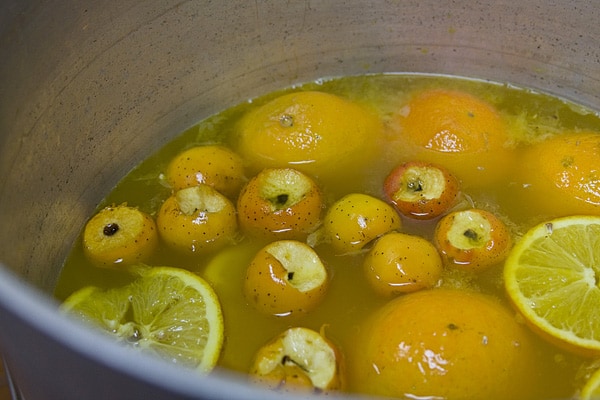
This recipe gives me such warm, fuzzy feelings and memories of being back in Mexico with our family for Christmas. Typically, this is a holiday punch, but in my house we sometimes drink it all winter long if we can find all the ingredients.
This recipe for ponche navideño comes from José’s abuelita Elda, who passed away in 2006.
While I never met Abuelita Elda, I’ve always felt like I had due to the abundance of stories I’ve heard about her and her cooking. My suegra taught me how to make her mom’s ponche recipe and someday I’ll teach my own children this holiday family favorite. I also learned that most families have their own recipe, so keep in mind this recipe isn’t the only way to make it. In fact, for a long time, nobody in our family knew that the secret ingredient in abuelita’s ponche navideño was Bonafina (a store-bought orange drink similar to Sunny Delight or Tampico Citrus Punch).
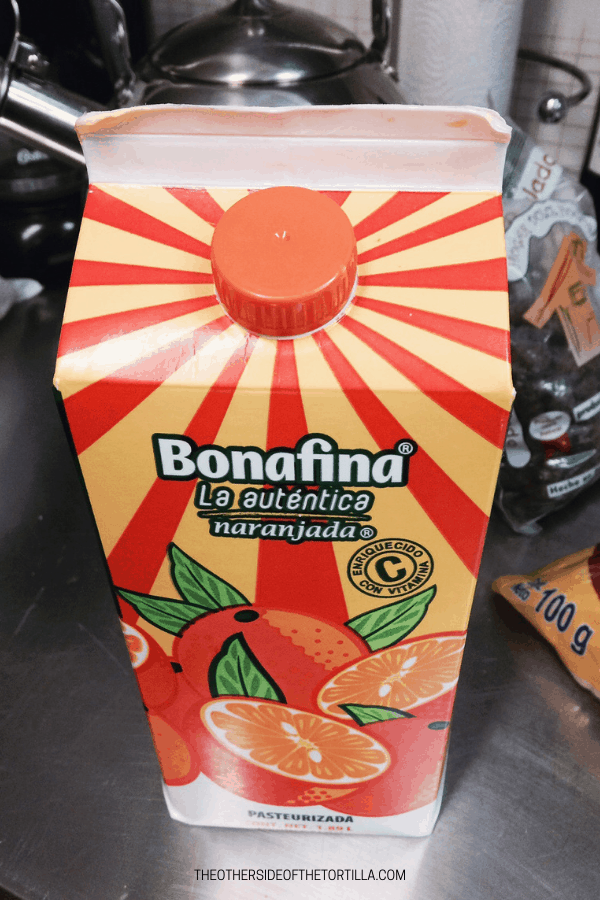
One thing I think everyone will agree upon, though, is there are some ingredients consistent in just about every recipe out there: Mexican guavas (guayabas), sugar cane (caña), Mexican hawthorn (tejocotes), cinnamon (canela), dried plums (ciruelas deshidratadas) and oranges (naranjas). How you put it all together is really up to you. Lots of people also use piloncillo to sweeten their ponche.
You might be wondering what some of the ingredients are and where to find them — specifically tejocotes.
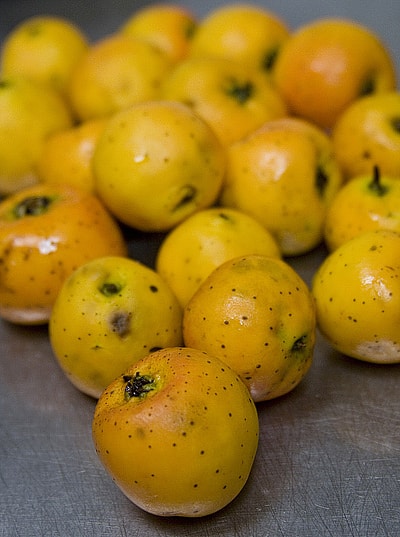 Tejocotes, also known as Mexican hawthorn in English, are part of the crab-apple family and have a tart taste with a hint of apricot flavor and a dense, pithy consistency when raw, somewhat similar to raw quince.
Tejocotes, also known as Mexican hawthorn in English, are part of the crab-apple family and have a tart taste with a hint of apricot flavor and a dense, pithy consistency when raw, somewhat similar to raw quince.
It’s a staple of Christmas posadas and is typically used in punches, jams and jellies.
If you live in California, you might be able to find locally-grown tejocotes at some markets, or even buy tejocote trees from a grower. Most Mexican supermarkets elsewhere should sell a ponche navideño mix in a glass jar and many have begun selling frozen tejocotes in the freezer section. Obviously, they’re not quite the same as if they were fresh, but they’ll do if you have no other way of obtaining the ingredients.
If you want to learn more about tejocotes, I recommend this December 2009 story from the LA Times.
Mexican guavas are the other ingredient you may not be able to find so easily. They have a yellowish skin that sometimes gets pink or purple-red spots when ripe, has creamy white flesh and a very pungent, tropical fruit smell. Though irradiated Mexican guavas have been USDA-approved since 2008, I sometimes have trouble finding them except at specialty produce stores or Mexican supermarkets. The more common pink-fleshed guava should not be substituted, as it has a different flavor.
Though some of the ingredients may be difficult to find, I promise it is worth the effort. I hope you enjoy this recipe as much as I do, and I hope you’ll share your memories or tips on how your family makes ponche navideño.
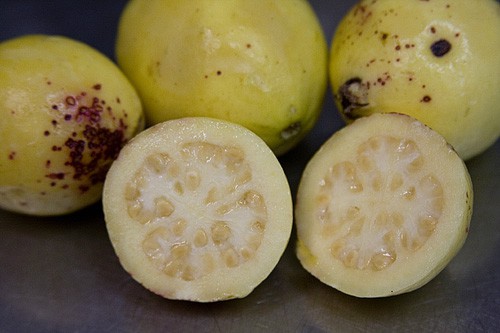
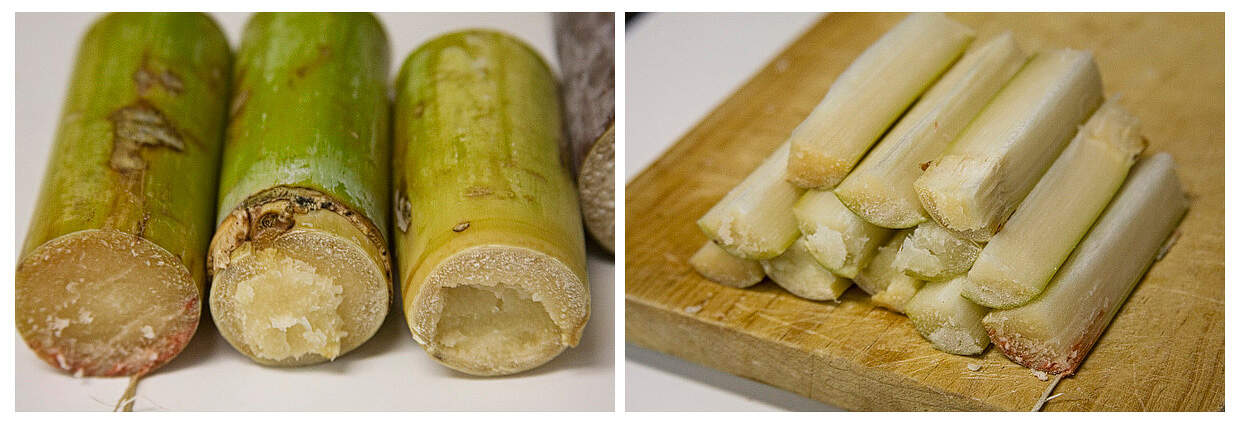
Ponche Navideño
Prep
Cook
Inactive
Total
Yield 12 servings
This Mexican Christmas punch, called ponche navideño, is served during Las Posadas, Nochebuena (Christmas Eve) and at holiday parties, and is often spiked with brandy or rum. It’s made with Mexican guavas, sugar cane, tejocotes, cinnamon, dried plums, and oranges.
Ingredients
- 5 to 6 cups water
- 5 to 7 Mexican cinnamon sticks (Ceylon cinnamon)
- 8 guayabas Mexicanas (Mexican guavas with yellow skin and creamy white flesh)
- 4 generous slices of orange plus 2 whole oranges
- 1/2 gallon Bonafina (sold in Mexico only); U.S. substitute: Original Sunny D or Tampico Citrus Punch
- 1-2 sugar canes, cut into small sticks until you have 12-18 pieces (think large carrot stick size)
- 3/4 to 1 cup dried plums (prunes; ciruelas deshidratadas)
Instructions
- Bring water and cinnamon sticks to a boil in a large pot over medium flame to infuse water with the cinnamon.
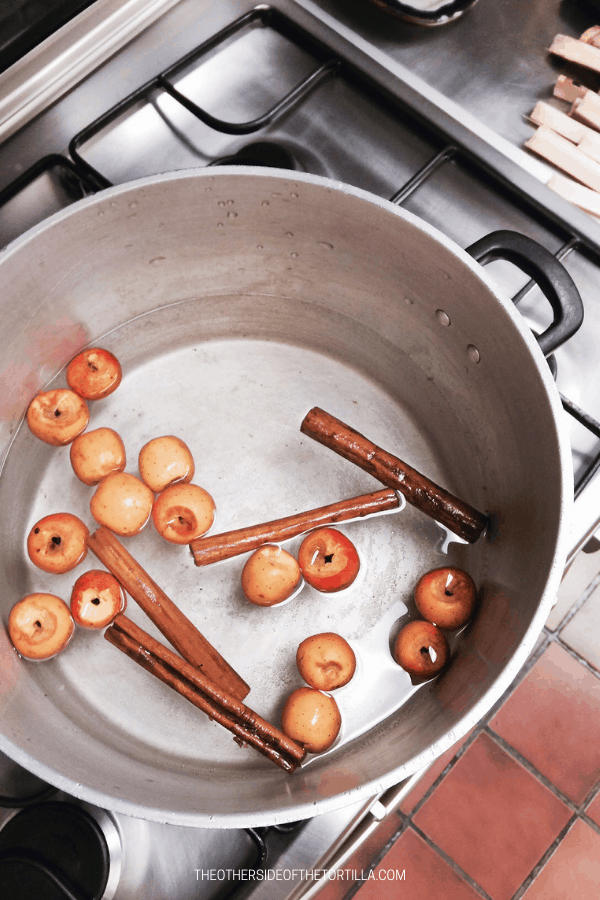
- Cut the top of the cores out of the tejocotes and halve the guavas. You can remove the seeds from the center of the guava if you like, but I leave them in for extra flavor while cooking. You can easily scoop out the seeds after cooking and before consumption.
- Add the tejocotes, guavas and orange slices to the cinnamon-infused water. Reduce heat and add the Bonafina or orange drink substitute. Halve the remaining two oranges, squeeze juice into the pot and then put the rinds into the pot as well.
- Cut the sugar cane into smaller sticks (see photo above). These are tough to cut; use a sharp knife, a sturdy cutting board and a lot of care to prevent any accidents. Add cane sticks to the juice and turn the heat back up to medium-high. Bring to a boil and allow it to boil for about 5 minutes. Reduce the heat to medium and allow punch to stew for 30 minutes. Reduce heat and allow to simmer for about another 40-60 minutes.
- Add dried plums during last 15 minutes of simmering so they don’t rehydrate too quickly from the high heat and start to fall apart. When it’s done simmering, you can either serve immediately, or place a kitchen towel over the top of the pot and let it cool and infuse more overnight. Discard the orange halves but keep the orange slices.
- Ladle punch into mugs and spoon some fruit and sugar cane into each mug as well. You can also garnish with a cinnamon stick for a little extra flavor if you like. To juice the sugar cane sticks, bite gently and suck the liquid out. Some of the punch flavor will have infused and the sugary liquid that will come out will have a citrusy spice flavor to it.
Notes
If you let it sit overnight, just reheat and serve. After that (if there’s any left), store in an airtight container and refrigerate for up to 5 days.
Note: if you make this recipe using a ponche Navideño mix from a jar, I suggest you pour out most — if not all — of the syrup in the jar before adding the tejocotes, guayabas and caña to the pot. You may also want to add a few tablespoons of granulated cane sugar to help sweeten it. I also find that I prefer a couple extra cinnamon sticks for a more spiced flavor.
Courses Beverage
Cuisine Mexican
39
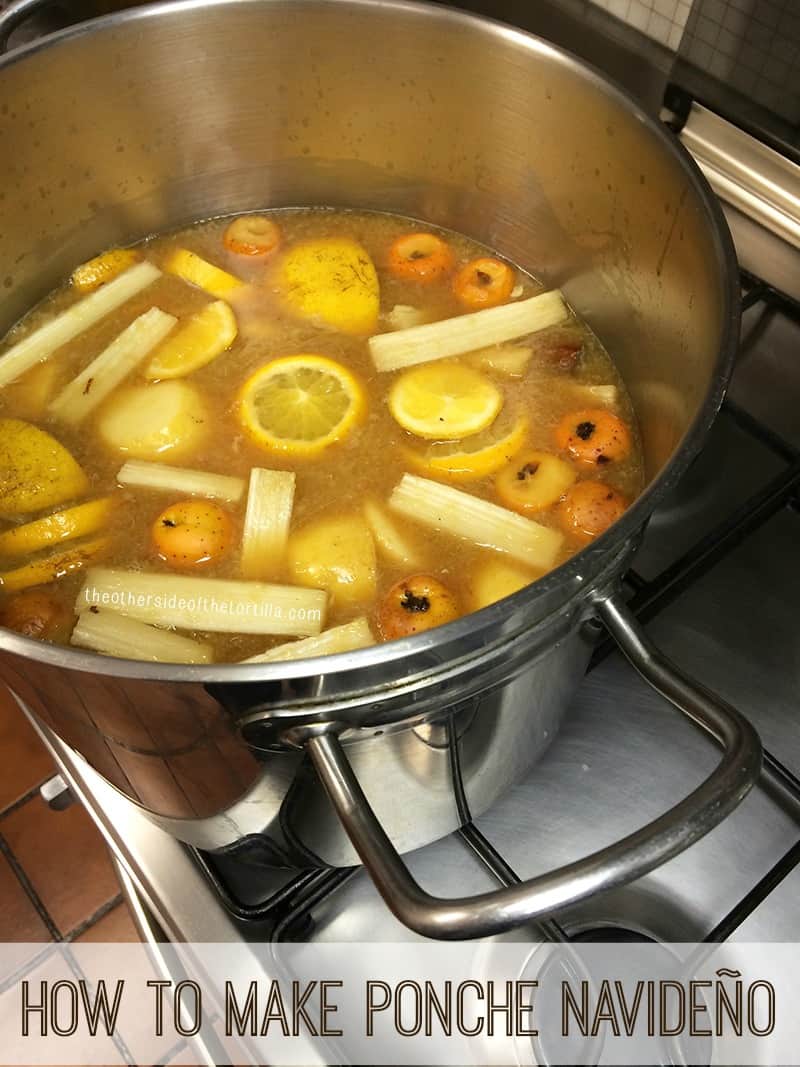
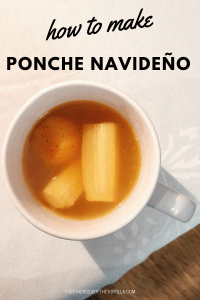
Some hot ponche is a great way to stay warm on a cold night. Especially with a little “piquete” of brandy.
I think Ponche is a great idea in January if you live in a place with snow and cold winters. I live in Toronto and I have tried to make Ponche, my family’s recipe is a little different, though… instead of Bonafina we use either Jamaica or Tamarindo, which gives it a more bitter taste. We also use apples, we dice them and include them with the rest of the fruit.
In my case it has definitely been a challenge to find both tejocotes and fresh guayabas, so I have substituted the first with dried apricots and the second with canned guavas… of course the result is not the same, but when you are far away from Mexico any attempt to recreate a Mexican dish (or beverage in this case) is welcome!
And, as Eric says, if you add a little bit of rum or brandy… it can warm the coldest night!
Eric, you’re right–I forgot to mention that it’s common to add a splash of alcohol (usually rum or brandy as Gina noted above) to make this a little more of an adult beverage. Some like to add more than a splash 😉 it’s really up to you!
Gina, thanks for reading and sharing what your family does differently. I imagine it’s difficult to find a lot of common Mexican foods and cooking ingredients in Toronto. Living in Chicago makes it fairly easy for me to find a lot of what I’m looking for because of the large Mexican population here. Sometimes I think about what it would be like to live in another city or state here in the U.S. that doesn’t have a large Mexican community (and all that comes with it: Mexican grocers, authentic restaurants, bakeries, tortillerias…and most of all, just culture in general), and I wonder how some people raise their kids and expose them to Mexican culture if they can’t really teach them about food, which is such a big part. It makes me all the more grateful to have so much at my fingertips here!
Are there particular mexican stores in the chicago-land area that you shop at over others? I am going to try this recipe this winter and am in the area – thought I’d try a store you regularly shop at.
I came across this article looking up information on tejcotes. We are the business that the LA Times article is talking about. We often hear the same complaint from our employees that have family in chicago that they cannot find fresh tejocotes and guavas.The distributors that we deal with do send both fruits to chicago but I’m not sure to what markets they sell to out there. If you want to let me know the names of the local latin markets that you buy from and we can try and talk to our distributors. The problem isn’t that there isn’t enough tejocotes it’s that sometimes the distributors or the stores don’t want to take the risk of buying it in large quantities because they are not familar with the product. We have fruit sometimes that we are not able to sell due to that reason. If we could grow the demand for tejocotes in areas like yours then it would be easily available through out the holiday months. We are already starting to harvest and ship some tejocotes to our local distributors so if we could find out what stores would be interested you could have tejocotes in your area for this holiday season. Thank you in advance for any information that you may have.
Thanks
Ricardo Serrato
Maura, this is such an interesting recipe! I never would have thought to use an orange drink like Tampico as the base for Ponche. I love that!!! It sounds really good and so different from the usual Tamarindo or Jamaica based ponches. I will definitely have to try this. 🙂
And our piquete of choice is always tequila. Felices Fiestas. 🙂